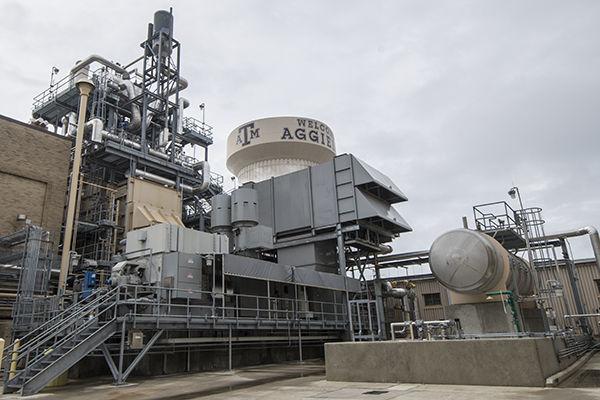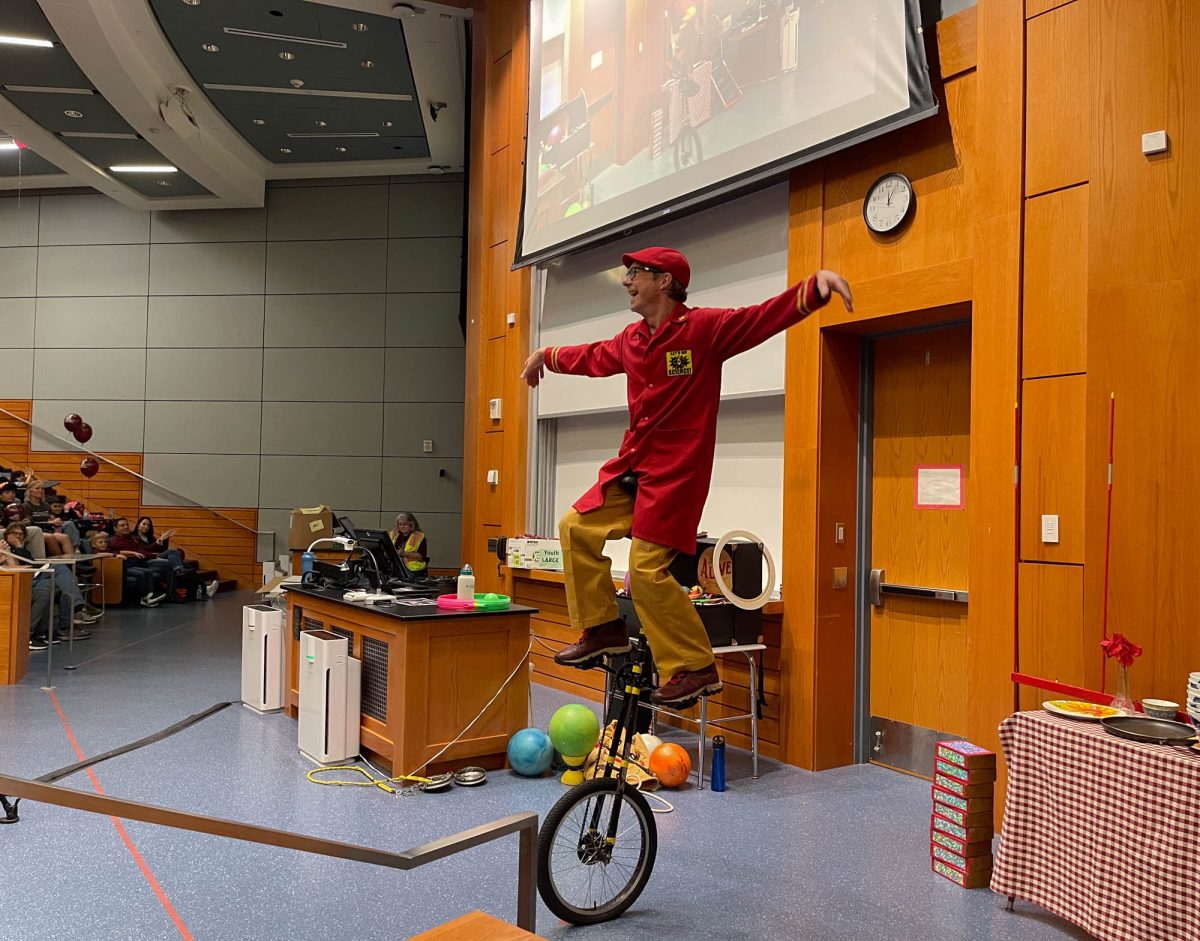There is a jet engine housed on campus, but it’s not at Easterwood Airport.
Utilities and Energy Services works behind the scenes every day to keep campus running. The combined heat and power plant, CHP, located near Blocker, acts as the central utility plant on campus. Along with a jet engine, which acts as the facility’s gas turbine, the Central Utility Plant includes a steam turbine from 1956.
“This thing was built like a tank,” said Zach McNew, communications specialist for UES. “It’s military spec, the same thing you’d find on a warship, like in WWII. So we just took the cover off, put new modern gages, new modern switches. It’s like a classic car. You do some updates and it’s still good.”
Jim Riley, executive director for Utilities and Energy Services, said people don’t always think about how their water and electricity reach their buildings, which he said might be a good thing.
“We don’t want people thinking about us because something’s not working,” Riley said. “What they don’t know is what all goes into making sure that everything works exactly the way it’s supposed to.”
Riley said UES provides basic utility and energy services to the entire campus, about 24 million gross square feet and about 800 buildings. Approximately 19 million of that is conditioned space, meaning it can be cooled and heated.
Along with the central plant, McNew said there are three subs on campus, located near the Military Sciences Building, Reed Arena and the vet school.
Riley said one issue UES deals with is student growth. With the College of Engineering’s 25 by 25 Initiative aimed at increasing engineering enrollment to 25,000 students, Riley said the university projects a student population of between 65,000 and 67,000 by 2025, not including faculty and staff. UES works to keep its “finger on the pulse” to gain a better idea of where the growth is coming from. Riley said UES completes an infrastructure master plan every five years that reviews proposed construction projects for utility needs.
With a staff of a little under 200, McNew said UES is in charge of energy production, distribution, management, maintenance and monitoring. The buildings are monitored by the world’s largest building automation system. McNew said there are 45,000 data points that are monitored around the clock by UES staff.
Along with developing and maintaining utility and energy within all the facilities, UES is also involved in the designing phase. James Massey, senior executive associate vice president for facilities, said this system ensures utility needs of each project are met.
“If a project is going to have an extraordinary need for air conditioning or power or whatever it may be, knowing that as soon as possible will make sure that if there are any management or construction needs that need to be added, we can do that so that when the project is complete, the kind of support they need is available,” Massey said.
One focus for UES is to make Texas A&M function as independently as possible. Riley said A&M has been producing its own power as far back as 1893.
“Our systems are completely and totally independent,” Riley said. “We have our own domestic or municipal water system, and we have our own waste water treatment plant. We have our own electrical power generation, and we purchase natural gas and electricity from the wholesale marketplace, all completely separate from College Station or Bryan.”
One example of the scope of UES is the cooling capacity, or air conditioning.
“We have 60,000 tons of cooling capacity to serve campus, and if you figure a typical house might have 5 tons, that gives you a sense for the capacity of the production capabilities of the utility plants on campus,” Riley said. “A small house might have 2 or 3 tons. If an average house is 3, 60,000 tons is enough to serve 20,000 average-size residential homes.”
The Central Utility Plant, which underwent a $73.25 million renovation in 2011, McNew said, is where all the power for campus comes from, along with water.
The energy starts with the jet turbine, which creates electricity for campus as well as enables the function of the rest of the facility. Zach said much of the turbine’s heat would be lost in a typical utility plant. One thing A&M does to stay efficient is harness that heat to run other parts of the plant.
“Typically the heat that comes off of this unit is wasted,” McNew said. “It’s 1,500 degrees. It’s hot enough to melt aluminum. What we do with that heat is we recover it. So literally it’s a heat-recovering steam generator. We’re recovering this heat, producing steam and then that steam is running another turbine and that steam is also running chillers for cooling.”
Riley said operating more efficiently has also allowed UES to reduce energy consumption by almost 45 percent, even with a campus that has increased in square footage by about 30 percent since 2002.
“If you correlate that to cost, what we sometimes refer to as cost avoidance, there has been $180 million in cost avoidance associated with those efficiency improvements over the last 12 years,” Riley said. “That $180 million is money that we didn’t have to pay a utility company for electricity to natural gas, so that $180 million is money that can be reinvested in teaching research classrooms facilities and the core mission of the university.”
Riley said UES runs like a not-for-profit business. Each customer within the university receives a bill, and if students are involved, like in the Department of Residence Life, a portion of student fees go toward the utility bill.
“They pay for their own utilities just like if they were running an apartment complex, and then they have to charge not just for utilities, but all of their operating expenses have to be recovered through their rental or their dorm rooms,” Riley said. “Indirectly, the charges they charge for their residence halls would go toward not only paying for utilities but maintenance and all the other operating expenses.”
Carol Binzer, director of administrative and support services in the Department of Residence Life, said her department is UES’ largest single customer. The yearly bill ranges somewhere between $8-$10 million.
“We have so many issues with the age of the buildings and leaks and maintenance that our bill is all over the map,” Binzer said. “We have not seen huge savings.”
However, Binzer said she meets with UES once a month to go over the details of each bill so that problems can be identified before they become worse.
“Utility and energy services is very helpful as partners, especially when we’re building and renovating, establishing a new baseline,” Binzer said. “Otherwise, they’re helping me identify ways I can make repairs or small things that don’t involve changing out the whole system.”
While they mainly work behind the scenes, Riley said UES has several initiatives meant to familiarize students with their utility infrastructure. A group of six stewards work around campus where they interact with users. They also offer tours of the Central Utility Plant so that students and staff can learn more about the facility itself.
“Facilities and utilities infrastructure required to meet essential human comfort and safety requirements is an important part of our daily lives, and essential to meet teaching and research mission at Texas A&M,” Riley said. “It is smart for students to be aware of and learn about the systems that are required to meet essential needs as part of their overall education.”
Inside the department that keeps the lights on
November 11, 2014

Tanner Garza — THE BATTALION
Texas A&M’s 45,000 data points around campus are monitored around the clock by members of the UES staff.
0
Donate to The Battalion
$2165
$5000
Contributed
Our Goal
Your donation will support the student journalists of Texas A&M University - College Station. Your contribution will allow us to purchase equipment and cover our annual website hosting costs, in addition to paying freelance staffers for their work, travel costs for coverage and more!
More to Discover









